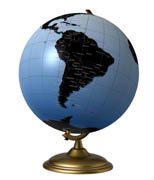The carefully packaged information kit from Burger King Corp. contained a promising fact sheet on the fast-food chain’s investment activities in Latin America and the Caribbean.
“Burger King Corp. and its franchisees operate over 650 restaurants in 24 countries within Latin America and the Caribbean … System-wide sales in Latin America and the Caribbean were approximately $595 million in F ’04, representing more than a 12% growth over the prior fiscal year.”
But the facts tell only part of the story. As keynote speaker Beatrice Rangel told participants at the recent Wharton Latin American Conference, Burger King represents what can go right when a corporation invests in an area where nearly everything can go wrong. Investing in Latin America and the Caribbean requires more than capital, patience and perseverance, she said. It requires investors to commit themselves to understanding the fragile business infrastructures within a part of the world that is fraught with volatile political, economic and social conditions.
“Representatives of Burger King have seen the peaks and valleys in Latin America,” said Rangel, a native of Venezuela, former chief of staff to former Venezuelan President Carlos Andres Perez and a corporate strategist who worked with the Miami-based entertainment conglomerate Cisneros Group before she was named managing director of AMLA Consulting, the Miami affiliate of Zemi Communications. “When you talk about investing in Latin America and the Caribbean, investors have to be patient. They have to look at the structures or lack of structures in the countries where they want to do business. And they have to understand that a good business will go through peaks and valleys, but in the end, it can continue to grow.”
Rangel made no attempts to sugar-coat the nature of doing business in the southern American hemisphere as she presented the current economic status of Latin American countries after more than a decade of relaxed trade and investment restrictions through such treaties as the General Agreement on Tariffs and Trade (GATT), which has a global focus, and regional pacts like the North American Free Trade Agreement (NAFTA). With slides and graphics, she explored answers to a series of six unfortunate questions about the current Latin America business environment: Is it as bad as it seems? Who concocted this recipe? Were the ’90s a ‘lost decade’? What went wrong? Can it get worse? What can be done?
The headlines chosen by Rangel in her first slide illustrated the volatility of the various Latin American countries. For example: “Venezuela shattered by political instability as President Chavez takes over” … “Evo Morales holds economic policy at ransom in Bolivia” … “Argentina’s return to capital markets lost in arrears.”
From an economic front, Rangel explained, the 2000-20003 world economic slump placed a heavy toll on both developing and high-income Latin American countries, as economic activity dropped significantly, consumer prices rose and unemployment continued to climb. “The economic front has not looked much better over the past three years,” Rangel said, noting that gross domestic product growth throughout Latin America has only begun to climb back to 2000 levels in 2004-2005 forecasts. “There is political instability because none of these countries has a safety net. When you open the countries (to trade) and they start experiencing changes with the rest of the world, their expectations change radically, for the better. But then the world economy goes into a slump and that creates tensions.”
What Rangel called “The Washington Consensus” helped create a recipe for trade and political reform in Latin American countries in the 1990s that called for open markets, deregulation, foreign direct investment, and a focus on macro-economic stability. Partly as a result, all Latin American and Caribbean nations except for Cuba are now under democratically-elected governments. According to Rangel, strong structural political reforms and stabilization efforts have been implemented in Argentina, Chile, Peru, Dominican Republic and Bolivia; moderate reforms are in place in El Salvador, Uruguay, Costa Rica, Guatemala, Mexico, Paraguay, Colombia and Jamaica; weak reforms and instability still dominate Brazil, Ecuador, Honduras and Venezuela.
“From a political point of view, of course, the 1990s were not a lost decade,” said Rangel, adding that those countries that showed the most progress in political reform also showed the strongest growth in gross domestic product from 1991 to 2000. From 1981 to 2001, developing countries also began exporting more manufactured goods from their own factories. And the countries that experienced the most serious and sustained political reform passed along another benefit to their consumers: dramatically reduced inflation rates. In Argentina, for example, the average yearly inflation rate in the pre-reform years was 1382.8%; in the post reform years, the inflation rate had dropped to 4.5% a year. Said Rangel, “For consumers and the poor there were gains as inflation almost disappeared.”
“So what went wrong?” Rangel asked, and then answered:
· Most Latin American countries were not able to do anything about the discrepancies in income distribution, with poverty remaining stagnant or increasing in the majority of the countries. With few exceptions, Latin America has been unable to bridge the gap between the rich and the poor.
· Latin American countries failed to penetrate developed countries’ agricultural and manufacturing markets. By the year 2000, developing Latin American countries accounted for only 12% of manufacturing exports and only 14% of agriculture exports. In trade logistics, the developing countries fell behind, too, requiring nearly five times as many days to clear sea cargo customs as other developed countries, an infrastructure problem that adversely affects air traffic, transportation and trade opportunities.
· The developing countries continued to lag behind in providing financial, communications and telecommunications services.
The one thing that clearly went well, Rangel explained, was the rise in political awareness among Latin American citizens. Clearly, she sees the promise of political stability as the lynchpin that may allow Latin American countries to one day move forward with regard to investment incentives. New political awareness in parts of Latin America has allowed non-governmental organizations or NGOS to flourish, promoting change in areas ranging from human rights to military budgets. “While the NGOs often create political instability,” said Rangel, “they are also going to create opportunity. They are the watch dogs. Two heads of state in Costa Rica would not be indicted and charged with corruption if it hadn’t been for the NGOs. Observance of human rights has been due to NGOs. True, they sometimes push too hard … But over the long run, they are good, because they lead to civic questioning of political parties. And people under a political climate of freedom demand effectiveness from governments. Indigenous people want jobs, housing, and education for their children.”
Rangel was quick to note that the situation in Latin America and the Caribbean can get worse, that any progress made over the last 10 to 20 years could be wiped out “if trade doesn’t continue to grow. With chronic political instability, you don’t get the influx of investors that you need.” Also, if growth stops and poverty increases, the growth-trade relationship could be jeopardized. In the worst possible scenario, she said, the disparity in income distribution would “not get better. You would have more Venezuelas, where development and growth would be impossible.”
In a damning indictment of her native country, Rangel said later during a question and answer session that she has all but given up on Venezuela, a country of stark contrasts between rich and poor, and the scene of constant political upheaval. “Venezuelans are beyond the point of return. They are going to kill themselves. I discount them for the next 10 years.”
But Rangel did not leave her audience without hope. In order to preserve the economic gains of the 1990s, to provide opportunities for investors and to give Latin American people “the down payment to the future,” Rangel proposes that the billions of dollars in remittances — money sent to Latin America from outside sources — that flow yearly into Latin America from the United States, Japan, Europe, Canada and intra-regional sources be used to “build trust in democracy and economic growth.”
How? By using remittances to provide homes. This year, said Rangel, billions of dollars in “remittances to the region are going to break all records. For example, in spite of the oil price surge, remittances are going to be even more than the exports of petroleum.” In Mexico alone, the Pew Hispanic Center estimates that money transfers each year from the United States into the country are greater than the annual direct investment in Mexico by foreign investors.
“These remittances can be put to use in a mortgage system that would give the disenfranchised a home,” Rangel said. “If you manage to give these people one asset that will allow them to think that they can rely on the future, to help them understand private property and feel security and safety, they will have a preference for stability.”
Granted, home ownership alone won’t solve the problems facing Latin American countries. To survive and attract investors to this region, and to preserve the progress that has been achieved, Rangel suggests that major changes be made to the Trade/Foreign Direct Investment (FDI) paradigm. Though the principle behind FDI (that is, capital seeking its highest return) indicates that capital should flow from developed, capital-abundant countries to less-developed countries (where capital is scarce and higher returns can be realized), the opposite is often true. According to a recent study, FDI flows as readily to developed countries.
Rangel suggested that the Trade/FDI paradigm be changed to reflect “the other 75% of the world market, with the households of moderate to low income.” She also suggested that world trade negotiations give priority to “agriculture, labor-intensive manufacturing, services, infrastructure/logistics development, and intellectual property rights.” This new trade agenda would foster a more balanced growth within nations, she added, arguing that a “trade agenda that creates complementariness through labor mobility and enhances infrastructure development adds at least 2% to world GDP growth.
“Last but not least,” she said, “you have to develop and be a good corporate citizen.” For instance, meaningful corporate social responsibility programs can be designed to improve access to information, education and health care. “It’s not a question of desire,” she added, “but of need.”


